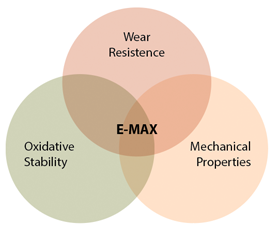Design Rationale
![]()
E-MAX Highly Crosslinked Polyethylene was developed to build on the lessons learned from the first generation of highly crosslinked polyethylenes (XLPE) and to address the trade-offs currently associated with these materials. In general, the goal was a material that fulfills three primary design requirements for a knee bearing: wear resistance, oxidative stability, and maintenance of mechanical properties.

Optimized crosslinking
Crosslinking reduces wear, but it has been also been shown to reduce fatigue and fracture resistance. [1] Compared to the highly congruent hip articulation, the knee has more cyclic loading and higher contact stresses, making fatigue strength especially important for this application. [1,2] Thus, engineers optimized the radiation dose, ensuring E-MAX for knees has a crosslinking density comparable to 7 Mrad XLPE.
Mechanically-annealed, rather than melt-annealed
Currently available XLPE is melt-annealed to eliminate the free radicals that lead to oxidation and subsequent polymer degradation. The reduction in mechanical properties caused by melt-annealing is well-known. E-MAX is annealed using a proprietary mechanical compression process. This mechanical annealing eliminates free radicals—like melt-annealing—but does not diminish the mechanical properties of the polyethylene. [3,4]
Vitamin E-blended to address oxidation
Furthermore, recent retrieval studies of melt-annealed inserts have revealed unexpected signs of in vivo oxidation.[5,6,7] E-MAX contains 0.1%-weight vitamin E, which acts to scavenge free radicals, thus hindering the polyethylene oxidation cascade. [8]
- Baker DA, Bellare A, Pruitt L. The effects of degree of crosslinking on the fatigue crack initiation and propagation resistance of orthopedic-grade polyethylene. Journal of Biomedical Materials Research 2003; 66A(1):146-154.
- Hodrick JT, Severson EP, McAlister DS, Dahl B, Hofmann AA. Highly crosslinked polyethylene is safe for use in total knee arthroplasty. Clin Orthop Relat Res 2008; 466:2806-12.
- Bhattacharyya S, Matrisciano L, Spiegelberg S, Harris W, Muratoglu O. Mechanical elimination of residual free radicals in an irradiated UHMWPE rod: advantages over melting. 50th annual meeting of the orthopaedic research society. 2004:1474.
- Gomez-Barrena E, Medel F, Puertolas JA. Polyethylene oxidation in total hip arthroplasty: evolution and new advances. The Open Orthopedics Journal 2009; 3:115-120.
- Kurtz SM, MacDonald D, Brenner E, Medel FJ, Hozack W, Parvizi J, Goldberg V, Kraay M, Stulberg B, Rimnac CM. In vivo oxidation, oxidation potential, and clinical performance of first and second generation highly crosslinked acetabular bearings for THA. Poster No. 1790 54th Annual Meeting of the ORS, 2008.
- Currier BH, Van Citters D., Currier JH, Collier JP. In Vivo Oxidation in Remelted Highly Cross-Linked Retrievals. JBJS 2010; 92(14):2409-18.
- Muratoglu, O. K., Wannomae, K. K., Rowell, S. L., Micheli, B. R., Malchau, H. Ex Vivo Stability Loss of Irradiated and Melted Ultra-High Molecular Weight Polyethylene. JBJS 2010;92:2809-2816.
- Costa L, Bracco P. Chapter 21 Mechanisms of crosslinking, oxidative degradation, and stabilization of UHMWPE. In UHMWPE Biomaterials Handbook Second Edition (ed. Kurtz SM). Elsevier: Amsterdam, 2009.